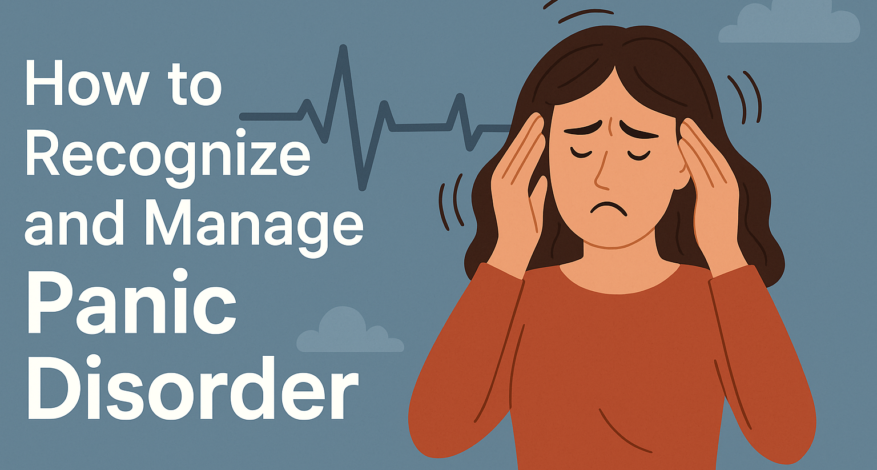How to Recognize and Manage Panic Disorder
Panic disorder is a common and often misunderstood mental health condition. It involves sudden and repeated episodes of intense fear, known as panic attacks, that can be overwhelming and physically distressing. While occasional anxiety is normal, people with panic disorder experience frequent attacks and persistent worry about when the next one might occur. This can significantly impact quality of life, relationships, and everyday functioning.
Understanding the symptoms, causes, and treatment options for panic disorder is the first step toward managing it effectively. This blog will provide a comprehensive overview to help you or someone you love recognize the signs and seek appropriate support.
What is Panic Disorder?
Panic disorder is characterized by recurrent panic attacks—sudden surges of fear or discomfort that reach a peak within minutes. These attacks can occur without a clear trigger and often feel like life-threatening events, even though they are not physically harmful.
Common Symptoms of a Panic Attack:
- Rapid heart rate or palpitations
- Shortness of breath or choking sensation
- Chest pain or discomfort
- Sweating, chills, or hot flashes
- Dizziness or light-headedness
- Trembling or shaking
- Nausea or abdominal distress
- Feelings of unreality or detachment
- Fear of losing control or “going crazy”
- Fear of dying
While a single panic attack doesn’t mean someone has panic disorder, persistent worry about future attacks and behavioral changes to avoid them are key indicators.
Causes and Risk Factors
The exact cause of panic disorder isn’t fully understood, but several factors may contribute:
- Genetics: A family history of anxiety disorders or panic attacks increases risk.
- Brain Chemistry: Imbalances in neurotransmitters like serotonin and norepinephrine may play a role.
- Stress and Trauma: Significant life stress, trauma, or ongoing anxiety can trigger the condition.
- Health Conditions: Conditions like thyroid problems or heart arrhythmias can mimic or trigger panic-like symptoms.
Understanding your unique triggers can help in managing the disorder effectively.
Diagnosis and When to Seek Help
If you experience frequent panic attacks and live in constant fear of the next one, it’s important to seek professional help. A mental health professional can provide a thorough assessment and rule out other conditions.
Diagnosis typically involves:
- A clinical interview
- A review of symptoms and medical history
- Possibly ruling out other medical issues (e.g., heart or thyroid conditions)
Early diagnosis and treatment can significantly reduce the impact of panic disorder.
Treatment Options for Panic Disorder
- Cognitive Behavioral Therapy (CBT)
CBT is one of the most effective treatments for panic disorder. It helps individuals understand the thought patterns and behaviors that trigger panic attacks and teaches healthier ways to respond.
CBT techniques may include:
- Cognitive restructuring
- Exposure therapy
- Breathing and relaxation exercises
CBT is evidence-based and often leads to lasting improvements.
- Medication
For some individuals, medications can help manage symptoms, especially during the early stages of treatment.
- SSRIs (Selective Serotonin Reuptake Inhibitors): e.g., sertraline, fluoxetine
- SNRIs (Serotonin-Norepinephrine Reuptake Inhibitors): e.g., venlafaxine
- Benzodiazepines: Fast-acting but typically used short-term due to dependence risk
Always consult a licensed healthcare provider to determine the best medication plan.
- Lifestyle and Self-Help Strategies
Alongside therapy and medication, these approaches can make a big difference:
- Regular Exercise: Reduces anxiety and improves mood
- Balanced Diet: Avoid caffeine, alcohol, and processed sugars
- Sleep Hygiene: Consistent sleep improves mental resilience
- Mindfulness and Meditation: Reduces anxiety levels and boosts relaxation
- Support Groups: Connects you with others facing similar challenges
Coping Tips During a Panic Attack
If you’re in the middle of a panic attack, these strategies can help:
- Deep Breathing: Focus on slow, controlled breaths
- Grounding Techniques: Use the 5-4-3-2-1 method to bring yourself into the present
- Reassure Yourself: Remind yourself that this will pass and is not life-threatening
Having a coping plan can reduce the intensity and duration of attacks.
Final Thoughts
Panic disorder can feel isolating and frightening, but it is highly treatable. With the right combination of therapy, lifestyle changes, and possibly medication, many people experience significant improvement—or even complete recovery.
If you think you may have panic disorder, don’t wait. Reach out to a mental health professional for a proper diagnosis and treatment plan. Remember: seeking help is a sign of strength, not weakness.
Recommended Resources







